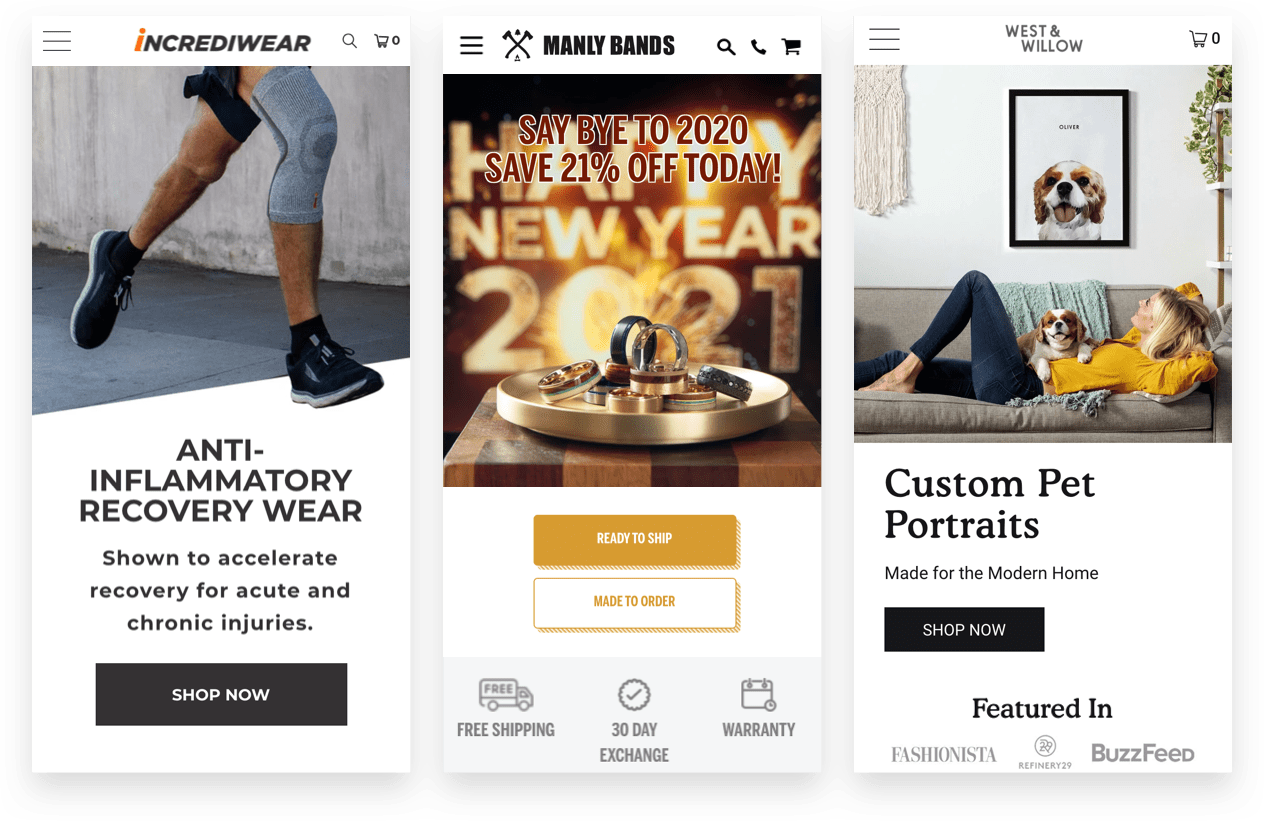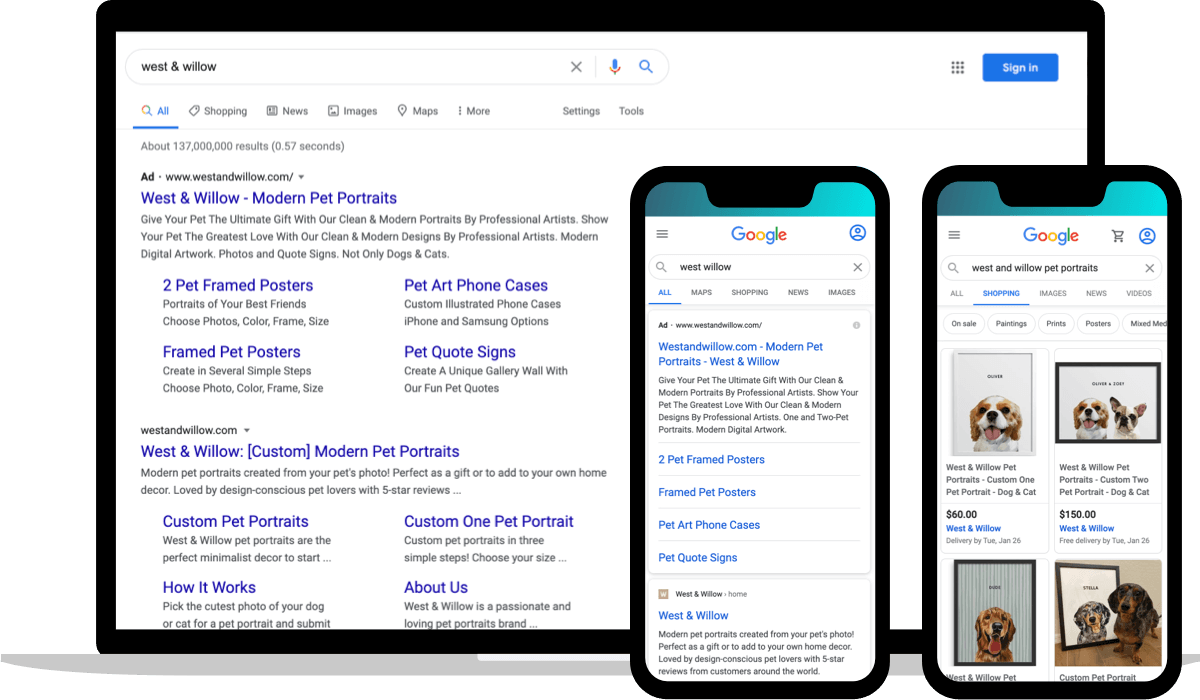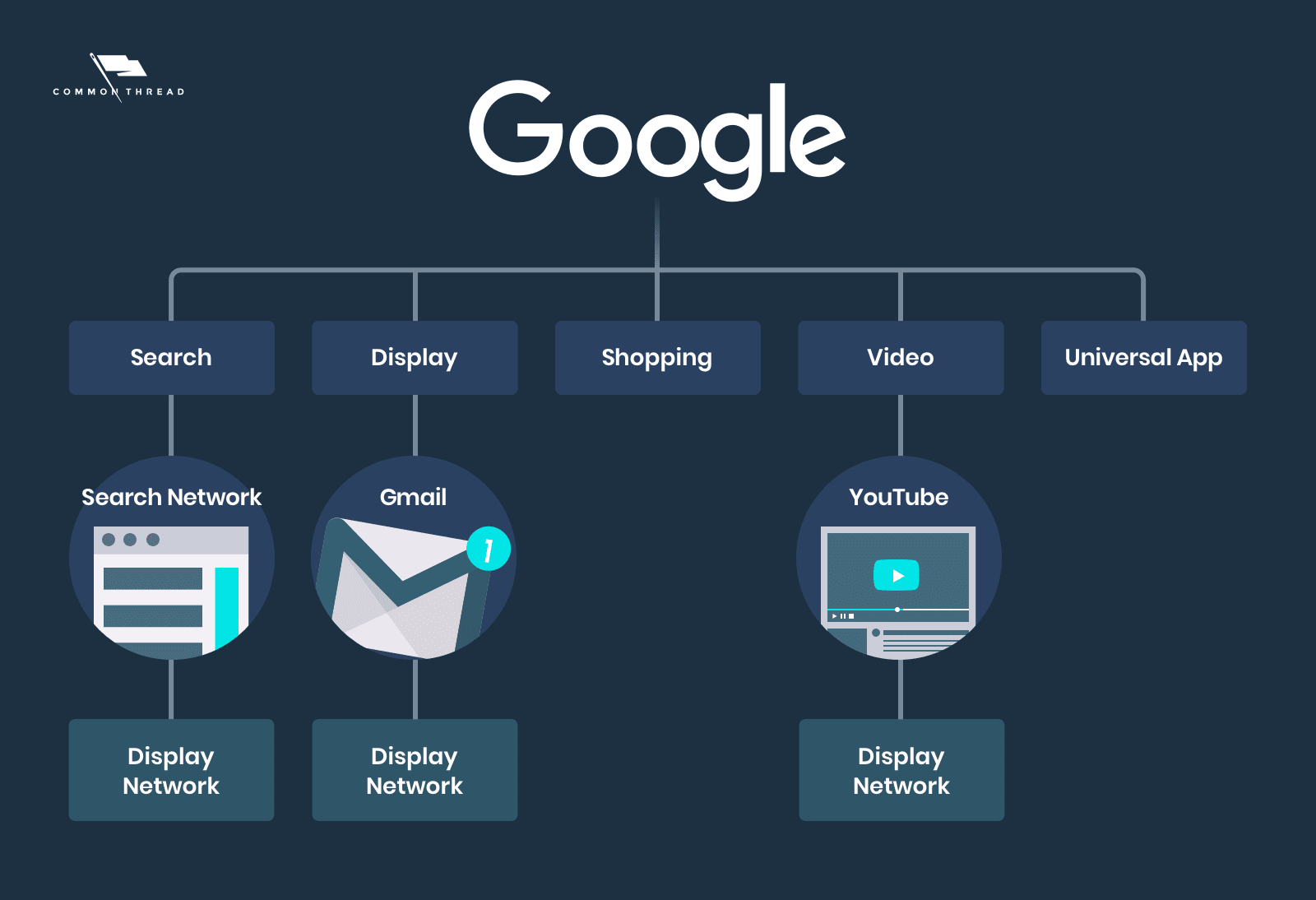
“Which is better: Google Ads or Facebook Ads?”
“Which is cheaper: Paid search or paid social?”
“What’s more efficient for my stage of ecommerce growth: advertising on Google or advertising on Facebook?”
Those are just a few of the questions owners and operators bring to the table when they’re putting together a digital marketing plan, navigating ecommerce trends, or just thinking about growth strategies.
Unfortunately, they’re the wrong questions.
People interact with Facebook Ads and Google Ads in fundamentally different ways. It’s not about either-or. In fact, you might already know, the right question is …
“How do I create, optimize, and track a full-funnel approach?”
To answer that question, and a few more, this article will guide you through five steps:
- Generate Demand with Social Media Advertising
- Capture Demand with Paid Search Marketing
- Expand Search Ads On & Beyond ‘Just’ Google
- Optimize Click-Throughs, Costs, and Conversions
- Balance Your Budget for Marketing Efficiency

1. Generate Demand with Social Media Advertising Platforms
“What’s the ‘fundamental difference’ between paid social and search?”
One word: intent — search has it; social doesn’t.
Those aren’t weaknesses; they’re strengths. As long as you know how to unite them. For our growth-team clients, that union comes from using paid social to generate demand; paid search to capture it.
Facebook advertising delivers value because it’s not intent-driven at all. It’s about having an open mind. Browsing. Curiosity.
Social ads present an opportunity to reach potential customer even when they’re not looking for you. If you’re used to the AIDA framework — particularly as it relates to marketing and advertising — then your focus will be on the first three letters: Attention, Interest, and Desire.
That doesn’t mean relinquishing ROAS (i.e., Action). Far from it.
“Alright, so how do you do that? How do you use Facebook ads profitably?”
Brilliant question. And one we’ve covered extensively.
Here are a few of my favorite paid-social resources …
Start by setting your foundation on a consolidated Facebook campaign structure. Center it on costs (CPAs) and budgets calculated off your own profitability targets.
Rapid growth comes from two sources.
First, letting Facebook do what Facebook does best — scaling through campaign budget optimization (the machine-learning side). Second, honing your ads through the offer: the sum total of your product, price, and positioning (the human-creative side).

“That’s pretty, Tony, thanks. But I need to see the differences in action. Can you get specific and show me that?”
Of course, I can. Throughout this article, we’ll focus on three brands: Incrediwear, Manly Bands, and West & Willow. I’ll use them as throughlines to illustrate the remaining steps.

2. Capture Demand with Paid Search (PPC) Advertising
Once you’ve invested in creating awareness and demand, it’s critical that you have a plan to capture that demand with paid search.
Specifically, how to handle (1) branded and (2) categorical search.
First, branded.
Quick definition — when we say “branded search” we mean showing ads on Google Search for your own brand terms. For West & Willow, these are the terms we advertise for:
- west and willow
- westandwillow
- west willow
- west & willow
- the west willow
- west and willow pet portraits
- westwillow

The awesome reality is that paid social advertising creates significantly more search volume for your brand on search engines.
It’s relatively predictable and you can use your paid social budget to estimate how much you’ll likely spend on brand search campaigns on Google.
Approximately 8% of your total paid social budget. Pretty easy math: If you’re spending $20k per month on Facebook and Instagram, then you’ll want to budget about $1,600 for Google brand search.
“Wait a minute. Why do I need to buy my brand terms on Google?”
Great question, and there are a bunch of factors. The most important one: Are your competitors showing ads on your brand terms?
If the answer is yes, then you’ll need to play “brand defense” so you don’t lose out on potential customers.
Second, categorical.
Categorical search is defined as all search terms that are related to your products. Let’s use West & Willow again:
- pet portrait
- pet pictures
- dog painting custom
- pet canvas art
- puppy portrait
- draw my dog

Search is intent-driven. Users are seeking solutions to problems, answers to questions. Search marketing demands getting in front of those users with the right answer to their question, exactly when they’re asking it.
Your potential customer may search for something like “custom painting of my hamster” on Google. And if you have a product that meets that need, then you definitely want to show up for that search.
But, this illustrates another difference between search and social.
Search is limited by the number of people searching for something. And the more specific the search (i.e., the more words), the less overall search volume there will be.
So, if you sell “custom portraits of hamsters,” you’ll want to show up prominently on Google — but that likely won’t be enough to achieve your overall business goals.
3. Expand Search Ads On & Beyond ‘Just’ Google Ads
For search-engine marketing, people typically think about two placements.
One, the text-based search ads — previously called Google Adwords — that appear on search engine results pages (SERPs). Two, Google Shopping Ads — also known as Product Listing Ads (PLAs): the picture ads at top of Google search results.
But that’s certainly not all the platform has to offer.
The landscape and product offering frequently change but for the most part you can break down the ad formats into these five categories:
- Search
- Display
- Shopping
- Video
- Universal App

We often frame Search and Shopping as mid-funnel activities. And then separate YouTube, Display, and Discovery to either the top — in support of awareness — or bottom — for remarketing.
In truth, YouTube, Display, and Discovery have far more in common with social advertising than what we traditionally define as search.
One of the ways the Google Ads platform has evolved over the last few years is the ability to outbound target audiences based on characteristics.
Current options include:
- Affinity audiences — With affinity audiences, you can reach people based on a holistic picture of their lifestyles, passions, and habits
- Life events — Engage with viewers on YouTube, Gmail, and Display around milestones like graduating, moving, or getting married
- In-market audiences — Select from these audiences to find customers who are researching and actively buying a product like yours
- Custom segments — Define your audience based on their specific interests, habits, and recent purchase intent
- Data segments — Serve ads to people who have already visited or taken action on your website
- Detailed demographics — Reach population segments with shared traits, such as college students, homeowners, or new parents
- Customer match — Similar to Facebook’s Custom Audiences from Customer Lists, you upload your customer lists to Google Ads
- Similar segments — Similar to Facebook’s Lookalike audiences, automatically find new customers similar to your existing customers
The CTC process ensures our clients are reaching their audience with social ads and that our clients show up prominently on the search results page.
By using these targeting options within Google Ad’s latest system overhaul — Performance Max — we’re reinforcing those marketing messages everywhere your potential customers are spending time online.
It’s an omni-channel strategy Google calls the “messy middle” and I like to call the “brand lasso.”

4. Optimize Click-Through Rate, Costs (CPC), & Conversion Rate
Now we’re making progress!
It’s not about Facebook Ads or Google Ads; it’s about how we can think about exploring both. And — when you’re thinking about Google Ads — it’s not just about the search page. An even better question is:
“How can I use everything in the Google Ads platform to support my digital advertising goals?”
When it comes to optimizing performance for each of the platforms, there are more similarities than differences. All advertising platforms rely on some form of “relative interaction” metric to measure engagement.
If I can only convince you of one thing, it’s that ad platforms value engagement over everything else.
Click-through-rate (CTR) is an excellent place to start any ad campaign analysis and optimization initiative. But make sure you start by understanding what a good CTR is for the type of campaign you're trying to improve.
For example, CTRs on brand search campaigns are always going to be higher than Shopping campaigns or anything on social. Relative CTR has to be your target.
The same way self improvement is relative to who you used to be, improving your ad campaigns is always relative to historical performance.
One of my favorite tests is different images on PLA Shopping Ads.
Why? To impact CTR! If a new PLA image can improve the CTR of a particular PLA from 0.45% to 0.65% — well that’s nearly a 45% improvement. Don’t let the small absolute value fool you.
The relative change is what is relevant and meaningful.
Cost per click (CPC) is always connected to CTR, regardless of the ad platform. One of the natural outcomes of optimizing your click-through-rate should be decreased CPCs.
But don’t stop there. Controlling the cost of your paid traffic is one of the most important levers you have in your marketing mix.
You have tons of options in both Facebook and Google around bidding strategies. If it was as easy as saying “always use this one” — well, it would be a lot easier than it actually is.
Instead of trying to get it right out of the box, plan to test and iterate through different bidding strategies. Record the results and choose the mix that leads to the best outcome for your business.
Conversion Rate (CR) is a key variable in CTC’s ecommerce growth formula.

ecommerce growth page and scroll down a bit until you see the video
It’s also a metric that has inputs outside of what’s happening in the actual ad platform. Said another way, if you’re optimizing conversion rates, you must consider what’s happening on your website itself.
Still, when optimizing for conversion rate on-platform, we think about all metrics relative (there’s that word again) to their (1) historical performance, (2) performance against account baselines, and (3) performance against similar campaigns.
Let’s say we have a non-brand, categorical search campaign running targeting “men’s wedding rings” for Manly Bands. And historically this campaign converts at 3%.

One potential test could be: What happens to the conversion rate if we change the keyword target from “men’s wedding rings” to “unique men’s wedding rings”?
Let’s say we run the test and find this keyword converts at 5%. “Ah-ha,” you say, “Winner!” And you’re not wrong.
Nonetheless, you also will need to factor in that you can likely drive significantly more traffic from a broader keyword target like “men’s wedding rings” than a more narrow keyword target such as “unique men’s wedding rings.”
Therein lies the balancing act you must always walk. Volume vs efficiency. Gross revenue vs profitably.
This is a good point to use CTC’s ecommerce growth formula to experiment with the effect different conversions rate have on your overall performance.
5. Balance Your Advertising Budget for Marketing Efficiency
“Thanks, Tony, I see now that I should invest in Facebook and Google Ads. But, how much should I budget for each?”
Another excellent question dear reader. You’re really catching on!
The answer here is very dependent on what you’re selling. The most efficient mix isn’t something we, you, or anyone can know up front … but something that we can test our way to a better understanding.
For most direct-to-consumer products in the categories that CTC works with — fashion and apparel, sporting goods, cosmetics and beauty, heath and wellness, and especially pet products …
We start with a 70:30 Facebook-to-Google ratio. If you spend $10k per month — $7k to social, $3k to Google.
This mix puts more resources towards creating brand awareness via social which is great. However, if your product solves a common, well-known problem, then there is likely large search volume accessible.
One client comes to mind, Incrediwear. Incrediwear sells high-quality, high-tech joint support products. Ankle sleeves. Knee sleeves.

There are lots of people searching Google for how to support their joints either for athletic pursuits or day-to-day living. This is a case where investment in Google and Facebook may come closer to 50:50.
Regardless of where you begin, it’ll be a starting point. From there vary the mix from month to month, adjusting up and down 10 points in either direction.
Try 80:20. Try 60:40.
And then watch to gauge the effect. How? I’m glad you asked …
Keeping Your Facebook Ads & Google Ads Accountable
Keeping your paid media accountable always means connecting advertising spend back to its relationship to revenue.
“If I run my own ads or hire an agency, what month-to-date (MTD) metrics should I pay attention to?”
- MTD spend vs target
- MTD revenue vs target
- MTD ROAS vs target
“What about month-over-month (MoM) KPIs at the ad level?”
- MoM cost per acquisition (CPA)
- MoM cost per click (CPC)
- MoM clickthrough rate (CTR)
The first two will tell you if the auction is getting more expensive. The third, what ads are grabbing — or not grabbing — customers’ attention. Together, they roll up into ROAS.
“Okay, but can you make that even simpler?”
Absolutely. Two big ideas worth considering, especially when you decide to work with an agency.
Number one: Marketing Efficiency Ratio (MER). MER is our core “macro” performance metrics. Total sales revenue divided by total ad spend.
It presents unlimited testing opportunities while marketers connect cause and effect between individual activities on individual marketing channels to the overall outcome.

Number two: Organic traffic as percent of paid. This one might be the secret to the whole thing.
The goal here is to have the share of paid traffic decline over time. To be successful, you need to acquire new customers organically and sell products repeatedly to existing customers through owned channels like email marketing and SMS.

CTC’s growth teams are experts at executing tactically on each platform. But also thoughtful about the omni-channel, big picture.
It’s not about Facebook Ads versus Google Ads. It’s about the most effective, efficient way to engage both platforms.
Create demand with social Ads. Capture demand with search Ads.
Don’t forget Google is more than just the search results page. Optimize for engagement. Examine the relationship between your advertising channels and test different budget allocations.
And when you’re running those tests make sure you’re measuring a big-picture, macro metric like MER to ensure the path you’re heading down is having a positive impact on your business overall.
We won't send spam. Unsubscribe at any time.

Tony is the Director of Paid Search at CTC. With 10+ years of experience and over 10k hours working in the Google Ads platform, his knowledge of paid search marketing strategies and tactics is extensive. Connect with Tony on Twitter or LinkedIn if you feel like ranting or raving about all things Google Ads.